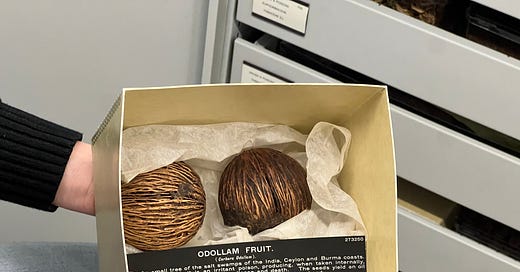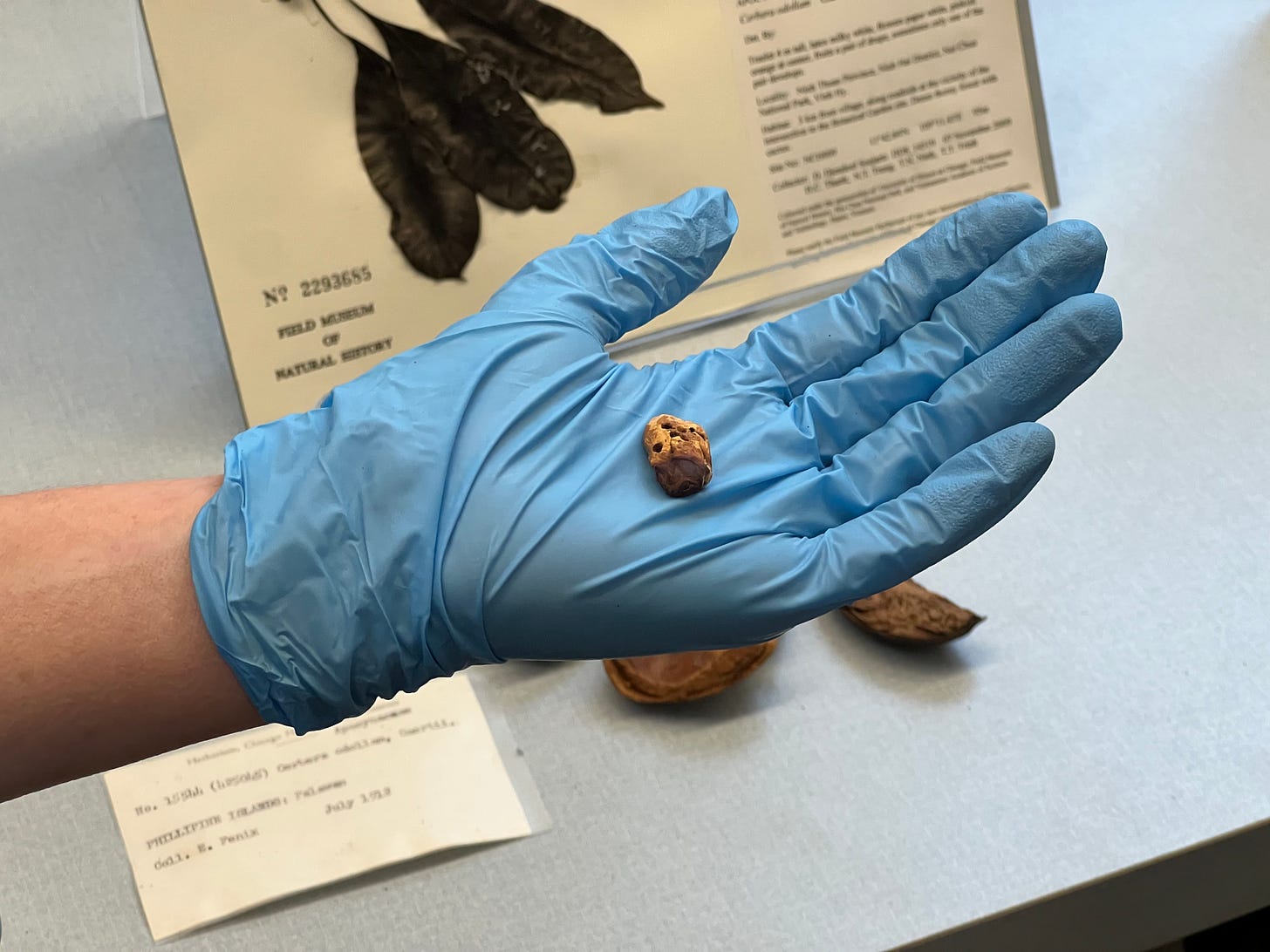An Entire Poison Plant Cabinet! (Plus White Lotus' Pong-Pong Fruit)
I'll try to avoid spoilers...
Hello, wonderful witches!
Today I put my stress and anxiety about the world to use, and headed to the Field Museum in Chicago to get a behind-the-scenes look at the archives’ poison plant cabinet. An entire cabinet filled with poison? How could I resist?
Aside from the general poisons in the collection, I was drawn in by the promise of seeing the deadly fruit from the most recent season of White Lotus: the pong-pong fruit. If you haven’t seen the season or the finale, don’t worry — I’ll try not to spoil anything and will use only generalities about the show.
But first, a few things about this collection at the Field. It’s officially called the Economic Botany Collection, and focuses on how people use plants, whether for medicinal or deadly purposes. The plants and specimens in the collection date back to before the founding of the museum, which was in 1893 to coincide with the World’s Columbian Exposition in Chicago. The poison plant cabinet is straight-up locked — no one can get in without the key. And apparently they only give that to researchers and scientists, which I find deeply unfair.
But also, probably smart, since it contains not only prepared plant poisons, but also a jar of ayahuasca; a box of plant species used to make poison darts; Crab’s Eyes wild beans, which are pretty poisonous but also used to make jewelry; castor bean seeds taken from the castor oil plant, one of the deadliest weeds in the world; and poison hemlock, which can cause major issues if you accidentally brush an open wound along the plant. Less than 1% of the Economic Botany Collection is on display in the museum, which made it even more exciting to be able to see what’s in the archives!
My journey through the world of poisonous plants was shepherded by Kimberly Hansen, a botanist and the Field Museum’s Collections Manager of Flowering Plants. (She refused to open the poison dart box, by the way, saying “I don’t want to open that. I don’t know what’s going on in there.”) Hansen explained that the poison and medicinal plant collection came largely from ethnobotanist Timothy Plowman’s collection. He was the world’s authority on the coca plant and died in Chicago in 1989, upon which his collection was passed to the museum.
The first specimen Hansen brought out — the pong-pong fruit itself, a specimen gathered in 1911 from India — was from Charles Millspaugh’s (1854-1923) collection. He was the Field’s first botany department curator. The pong-pong tree, also known as the suicide tree, is actually called Cerbera odollam. (It’s also awfully pretty, with green spear-shaped leaves and flowers that are white with pink interiors, reminiscent of plumeria flowers.) The entire tree is poisonous, but by far, the most toxic part is the seeds in the pong-pong fruit (which is actually called othalanga). Each fruit has two seeds, and they’re stuffed full of the poison cerberin. Cerberin is what’s known as a cardiac glycoside, which can be used as medicine to treat heart failure and irregular heartbeats.
As Hansen noted, “A lot of deadly things are also medicinal things.”
The pong-pong tree and its fruit are members of the milkweed family, commonly identified by the milky sap inside the plants. (You want to stay away from milkweed and its friends, trust me. “Never ever consume any plant that has milky sap. It probably won’t go well,” Hansen said.)
If you really want to poison yourself or someone else, just pop the whole, raw pong-pong seed inside the fruit into your mouth and wait. You’ll have to dig it out of the rough husk holding it in first, though. People can die from ingesting a single seed, and it can happen within the span of an hour.
That being said, not everyone dies from the pong-pong seed, so that scene in White Lotus is actually plausible. Most likely, you’d start vomiting immediately as your body tries to expel the toxic substance. If you didn’t ingest too much and you vomit enough, congratulations! You’re still alive. Keep in mind, though, as Hansen says: “Everything is edible once.”
And that leads to my most favorite use for the pong-pong seed: to determine who was a witch. Back in the 1800s in Madagascar, a judge and jury would feed suspected witches pong-pong fruit and seeds. If you could handle consuming the poison and survived the ordeal, you were dubbed not guilty of witchcraft. If you died, sorry — you’re a witch.
If you want to see the pong-pong seeds yourself, you can find specimens on display in the Field Museum’s Plant Hall. There’s also a Meet a Scientist event led by Hansen on Monday, April 14, at 11 a.m., that you can attend. Just don’t try to eat anything.








I had no idea there was a poison cabinet at the museum! I love just outside the city but haven't been to the Field in a while. ( I have been spending all my time at the art institute lately). This was fascinating...thank you for posting.